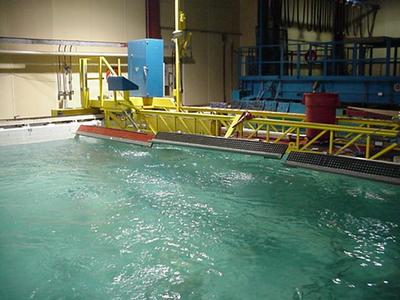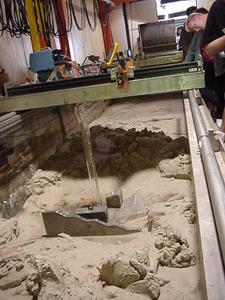6 August, 2002
And so the adventure begins! As with all properly planned adventures, this one begins with planning. The Teachers Experiencing the Arctic and Antarctic (TEA) program has assembled all the 2003-2004 field season parcticipants for an intensive week of preparation and training. We have gathered at the Cold Regions Research Engineering Laboratory (CRREL) in Hanover, New Hampshire.
Today, the Public Affairs Specialist from CRREL, gave us a tour of the facility. We saw research posters depicting projects such as de-icing aircraft, cold weather concrete construction, laying utility cables at South Pole, and clearing ice from lock systems. The facility employs approximately 300 scientists and support staff who are studying the effects of cold temperatures on all types of materials, structures, and equipment.
CRREL maintains several project rooms that are actually more like warehouses in size! One such room houses a water tank that looks somewhat like a giant swimming pool measuring 120' long, 30' wide, and 8' deep (picture, below). The water in the tank can be frozen to various depths, allowing researchers to simulate the effects of ice on different objects. For example, the laboratory is currently testing a scaled down model of the upper hull and sail of a submarine, sent here by the Navy, to test the elasticity of ice sheets of varying thickness. Scientists want to know how far the ice will
"give" before the submarine actually punches through the ice. In addition, they can determine the amount of stress put on the submarines hull and sail. Simulating with scaled down models eliminates the need to test with actual submarines!
Another interesting area is "The Flume." This room houses a giant stream tank that is used to simulate river systems; it is able to pump 500 gallons of water per minute. The Flume is currently being used to study the effects of water currents, ice, and sediment flow around structures such as bridge supports.
What peaked my interest was the cold rooms. CRREL has 24 cold rooms kept at various temperatures for storing equipment and conducting investigations at specific temperatures. We visited the cold room that houses ice cores maintained at -24°F. As we entered the room, I expected the cold air to smack me like a fly swatter, but instead, the cold air seemed to surround me and seep into my clothing. A sign of things to come?

1. The Ice Simulation Tank. _________________________________________________________________ Chat with friends online, try MSN Messenger: http://messenger.msn.com

2. The "Flume" set to test bridge supports. _________________________________________________________________ Join the world’s largest e-mail service with MSN Hotmail. http://www.hotmail.com

3. The ice cores in the cold room. _________________________________________________________________ Join the world’s largest e-mail service with MSN Hotmail. http://www.hotmail.com
Contact the TEA in the field at
.
If you cannot connect through your browser, copy the
TEA's e-mail address in the "To:" line of
your favorite e-mail package.
|
